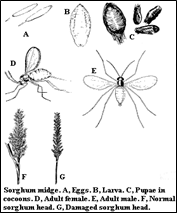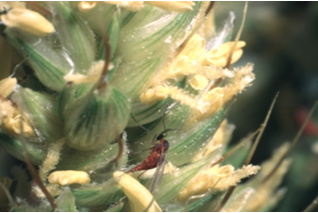
| Home |
| SORGHUM |
| 1. Sorghum Shootfly |
| 2. stem borer |
| 3. pink stem borer |
| 4. shoot bug |
| 5. earhead bug |
| 6. sorghum midge |
| 7. plant lice (Aphids) |
| 8. earhead web worm |
| 9. gram caterpiller |
| 10. plant bug |
| 11. stink bug |
| 12. mirid bug |
| 13. slug caterpiller |
| 14. Leaf roller |
| 15. flea beetle |
| 16. red hairy caterpiller |
| 17. semilooper |
| 18. weevils |
| 19. wingless grasshopper |
| Integrated Pest Management |
| Questions |
| Download Notes |
PESTS OF SORGHUM :: Major Pests :: Sorghum Midge
6. Sorghum midge: Contarinia sorghicola (Cecidomyiidae: Diptera)
Distribution and status: India, Pakistan, Bangladesh, West Iran, Sri Lanka, Sudan, Java, Africa, South East Asia, South China, South America, West Indies, USA and Italy.
|
|
|
Bionomics: The adult fly is small, fragile with a bright orange abdomen and a pair of transparent wings. It lays eggs singly in developing florets resulting in pollen shedding. A female lays about 30-35 eggs at the rate of 6-10 in each floret. The incubation period is 3-4 days. The maggot has four instars with duration of 8-10 days. Larvae are colorless, but, when fully grown, they are dark orange. Larval period 9 - 11 days. The larval stage undergoes diapause in a cocoon during December - January within a spikelet. Pupates beneath the glume. The pupal period 3 days. When the adult emerges the white pupal skin remains at the tip of the spikelet. A generation is completed in 14-16 days. The insect's rapid developmental cycle permits 9-12 generations.
|

|
Management
|

